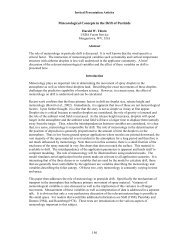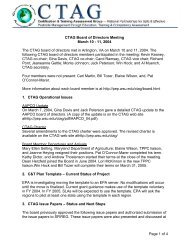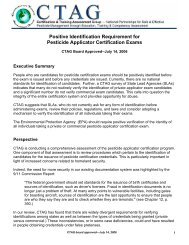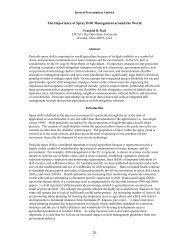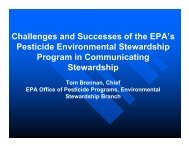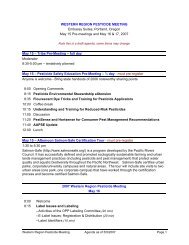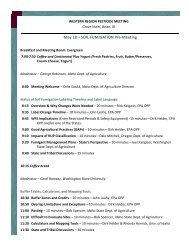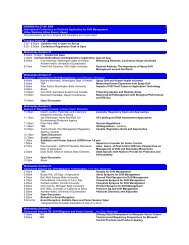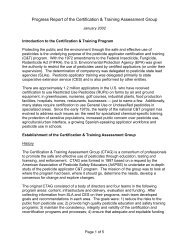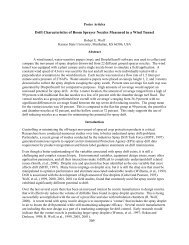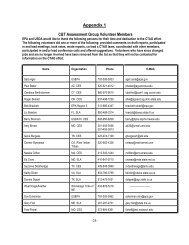Certification and Training Assessment Group (CTAG) Board of ...
Certification and Training Assessment Group (CTAG) Board of ...
Certification and Training Assessment Group (CTAG) Board of ...
You also want an ePaper? Increase the reach of your titles
YUMPU automatically turns print PDFs into web optimized ePapers that Google loves.
<strong>Certification</strong> <strong>and</strong> <strong>Training</strong> <strong>Assessment</strong> <strong>Group</strong> (<strong>CTAG</strong>)<strong>Board</strong> <strong>of</strong> Directors MeetingDecember 13-14, 2005Meeting SummaryThe <strong>CTAG</strong> <strong>Board</strong> <strong>of</strong> Directors met in San Diego, California on December 13-14, 2005. The following<strong>Board</strong> members participated in the meeting: Kevin Keaney, Carol Ramsay, Andrew Thostenson, GinaDavis, Jack Peterson, Dean Herzfeld, Jeaneanne Gettle, Kerry Richards, Kathy Dictor, Tim Drake,Richard Pont, <strong>and</strong> Michelle DeVaux, <strong>CTAG</strong> Secretary. Mike Fitzner, Director <strong>of</strong> Plant Systems forUSDA-CSREES attended in lieu <strong>of</strong> Monte Johnson. Dick Herrett <strong>of</strong> the National Association <strong>of</strong> StateDepartments <strong>of</strong> Agriculture Research Foundation (NASDARF) also attended the meeting. Severalinvited visitors attended the meeting: Kathy Davis, US EPA <strong>and</strong> Paul Liem<strong>and</strong>t, Minnesota Department<strong>of</strong> Agriculture.1. Operational IssuesAAPCO Presidency: Jack Peterson assumed the presidency <strong>of</strong> AAPCO upon the resignation <strong>of</strong> SteveRutz. He will fill the presidency for the remainder <strong>of</strong> Steve’s term, <strong>and</strong> then continue through theterm for which he was elected.Pesticide Safety Cooperative Agreement: EPA has entered into a 5-year cooperative agreement withthe National Association <strong>of</strong> State Departments <strong>of</strong> Agriculture Research Foundation (NASDARF) toreplace the expired agreement with the Council <strong>of</strong> Agricultural Science <strong>and</strong> Technology.New <strong>CTAG</strong> members <strong>and</strong> expiring terms: Paul Liem<strong>and</strong>t was elected to fill the seat <strong>of</strong> SLArepresentative/AAPCO liaison (vacated by Jack Peterson) <strong>and</strong> Janet Fults was elected to fill theSLA position (vacated by Gina Davis).Document updates - The board reviewed Goals <strong>of</strong> the 21 st Century Report <strong>and</strong> the Tracking Document<strong>and</strong> suggested minor changes, additions <strong>and</strong> deletions.2. Status <strong>of</strong> EPA ProgramsEndangered Species: In February <strong>and</strong> March a public meeting <strong>and</strong> a stakeholder conference will takeplace to address the changes to the regulation <strong>and</strong> associated information. The stakeholderconference will be held in conjunction with the Section 18 conference, <strong>and</strong> Jeaneanne hasrequested that it follow a train-the-trainer design to accommodate those states that are unable toattend. Arty Williams, now <strong>of</strong> the Environmental Fate <strong>and</strong> Effects Division, agreed to thisproposal. Kevin, Carol, <strong>and</strong> Jeaneanne agreed to coordinate with Arty to discuss the upcomingevents, the roles <strong>of</strong> engaged parties, <strong>and</strong> how <strong>CTAG</strong> <strong>and</strong> the Cooperative Extension Service canbe involved.Aerial Exams: EPA is in the process <strong>of</strong> developing a national aerial exam, in conjunction with theNational Agricultural Aviation Association (NAAA) <strong>and</strong> NASDARF.State Plan Template: Richard Pont provided an update sheet on implementation <strong>of</strong> the state plantemplate. The template will collect end <strong>of</strong> year reporting data. EPA’s strategy for reviewing thedata is to compare it to last year’s to ensure consistency, <strong>and</strong> then to e-mail confirmation to thestates. The <strong>Board</strong> suggested distributing a sheet on the accomplishments <strong>and</strong> successes <strong>of</strong> thetemplate, such as improved state plans, updated information, <strong>and</strong> easier reporting <strong>and</strong> planapproval.1
ecommended putting a summary list <strong>of</strong> resources based on the fact sheets on the <strong>CTAG</strong> website witha link to the full presentation <strong>and</strong> fact sheets, <strong>and</strong> exp<strong>and</strong>ing the existing presentation with informationfrom the presentation on funding resources for SLAs to make it more comprehensive. A list <strong>of</strong>traditional funding sources must be developed as well, including grants from EPA <strong>and</strong> USDA, becausethere are always people new to the certification <strong>and</strong> training program that can use the information. Theboard will send information on traditional sources to Carol or Kerry <strong>and</strong> non-traditional sources toAndrew. The compiled lists will be posted on the <strong>CTAG</strong> website <strong>and</strong> the presentation will be updated.7. PSEP FundingThe 2006 interagency agreement (IAG) package for $1.2M has been submitted to EPA’s grants <strong>of</strong>fice.2006 is the last year <strong>of</strong> the existing IAG. EPA plans to maintain a non-funded agreement with USDA inthe future to ensure an existing relationship <strong>and</strong> potential funding vehicle. Beginning in FY07, EPAplans to distribute funds for training <strong>of</strong> restricted use applicators in a different manner, probably throughcooperative agreements. The board highlighted the need to take into consideration the indirect costsassociated with any cooperative agreement. Kevin agreed to meet with EPA grants specialists toexplore options to eliminate or maintain low indirect costs in any agreements. <strong>CTAG</strong> will continue toraise issues, potential impediments <strong>and</strong> things to consider in this process. Mike Fitzner made clearUSDA’s willingness to continue passing EPA funds through the inter-agency agreement.8. Positive Identification for ExamsAndrew circulated the latest version <strong>of</strong> this draft issue paper in the new <strong>CTAG</strong> style template. Andrewmoved to adopt the draft issue paper with minor edits, Carol seconded the motion <strong>and</strong> it was approvedto be circulated to AAPSE, AAPCO, ASPCRO <strong>and</strong> other partners for their comments.9. EPA Regulation PowerPointEPA has briefed management on potential areas for regulatory change (around 26 changes) to bothapplicator certification <strong>and</strong> worker protection <strong>and</strong> has received positive feedback. The PesticideProgram Dialogue Committee (PPDC) subgroup on regulatory change will meet in early 2006. Carolrecommended having a <strong>CTAG</strong> representative on the PPDC subgroup. Once PPDC is briefed EPA willseek active input from all stakeholders including <strong>CTAG</strong>, AAPSE, AAPCO, ASPCRO.10. Facilitating ReciprocityThe board decided to keep the below two issues separate <strong>and</strong> move forward on both tracks.Best Management PracticesAndrew began the discussion with a history <strong>of</strong> the issue development <strong>and</strong> an overview <strong>of</strong> the existingissue paper. <strong>CTAG</strong> is seeking to develop a best management practices document (BMP) for facilitatingreciprocity to assist states in this area, rather than to attempt to implement requirements. Andrew willformalize the workgroup <strong>and</strong> focus on the following tasks: define terms, define processes, recognizeobstacles <strong>and</strong> concerns. The next step would be to develop a guidance manual <strong>and</strong> haverecommendations for tracking <strong>and</strong> recognizing reciprocal licenses from home-state licenses.Emergency ReciprocityPaul Liem<strong>and</strong>t was invited to discuss the issue <strong>of</strong> emergency reciprocity between states, based on hiswork as the AAPCO President. Paul presented a draft issue paper on emergency reciprocity to satisfy am<strong>and</strong>ate from NASDA to have some procedures in place in the event <strong>of</strong> an emergency. <strong>CTAG</strong> gavesome preliminary feedback <strong>and</strong> will send other comments to Gina.3
11. Performance MeasuresEPA Measures Development ProcessKathy Davis <strong>of</strong> EPA was invited in her role as co-chair <strong>of</strong> the EPA workgroup on Worker SafetyMeasures. The measures steering committee (high level management) has selected enforcementmeasures for the applicator certification program – demonstrated changes in behavior as measuredthrough recidividism. Kathy indicated that a potential role for <strong>CTAG</strong> within EPA’s measures process isto identify areas where the program is weak or realistic data is lacking.PPRS IndicatorsCarol distributed a document on the USDA PPRS committee’s (1999) suggestions for indicators. Afterexplaining the content, purpose, <strong>and</strong> need for consistency in CES reporting, she suggested piloting apre- <strong>and</strong> post-testing questionnaire <strong>and</strong> a 6 month follow-up questionnaire for trainers reporting inPPRS. Mike Fitzner gave a brief explanation <strong>of</strong> the development <strong>of</strong> PPRS under John Impson as asimple, web-based, easily accessible template for entering reporting data. Mike indicated thatstakeholders that wish to change PPRS can. Jeaneanne <strong>of</strong>fered to work with Sherry Sterling,coordinator <strong>of</strong> the EPA measures development process, to incorporate measures that are alreadysupported by USDA data collected. It was recommended that PPRS indicators be considered by EPAduring the reworking <strong>of</strong> the applicator training funding mechanism. The board agreed to continue to<strong>of</strong>fer any support to substantiate data <strong>and</strong> information to protect the applicator certification <strong>and</strong> trainingprogram <strong>and</strong> its funding.12. Ensuring Continued CompetencyEPA <strong>and</strong> states are tasked with ensuring applicator competency. This is done through testing, CEUs<strong>and</strong> m<strong>and</strong>atory workshops. The variety <strong>and</strong> rigidity varies greatly across the country. EPA plans toaddress this issue during the proposed regulatory changes. <strong>CTAG</strong> asked Kerry to form a workgroupwith three subgroups to define each system (testing, CEUs, workshops), evaluate the benefits <strong>and</strong>drawbacks <strong>of</strong> each, determine what happens if an applicator cannot meet the state requirements,gauge variability between states, find out how states h<strong>and</strong>le recertification for small categories,determine the system’s efficiency <strong>and</strong> how it can be enhanced, <strong>and</strong> make recommendations toimprove/enhance/modify each system.13. Exam/Manual Development WorkgroupEPA is considering addressing the quality <strong>and</strong> uniformity <strong>of</strong> exams during the regulatory proposal.<strong>CTAG</strong> formed a workgroup to research the issue <strong>of</strong> exam/manual development <strong>and</strong> prepare an issuepaper on the terminology strategy, benefits <strong>and</strong> barriers for states <strong>and</strong> tribes. This group will prepareinitial discussion points for the next <strong>CTAG</strong> board meeting. Tim Drake will co-chair the committee withMargaret Tucker (committee members include John Scott, Ron Gardner, Dean Herzfeld <strong>and</strong> DrewMartin).14. Next MeetingThe next board meeting will be June, 6, 7, 2006.4



